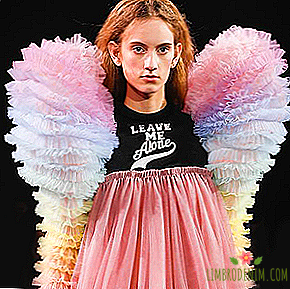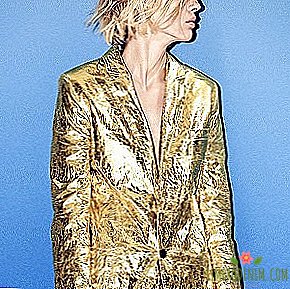Sonia Rykiel: Designer, who set the fashion for freedom
On the afternoon of August 25, the Elysée Palace issued an official press release, in which it was reported that Sonya Rykiel died. She was 86 years old, twenty of whom had Parkinson's disease. But most likely you yourself know about it - yesterday everything was written about Sonya, from newspapers and news agencies to blogs and fashion websites. Short notes with the main milestones of life, quotes from the daughter Natalie and listing the main merits of the world fashion: stripes, bright colors and, of course, knitwear. Ninety percent of the notes were called “Sonia Rykiel, the queen of knitwear, died”. As if this phrase in a vacuum means at least something.

“Sonya Rykiel, the queen of knitwear” is the fashionable equivalent of the school “Pushkin is our all.” It is better to know about the great poet, at least that he is great, than not to know at all, but is this really enough? Is Sonya Rykiel - is it striped sweaters? And who would be able to enter the history of fashion, think of it just a knitted sweater?
Her death once again showed how quickly and imperceptibly the reality changes. Sonia Rykiel appeared on the world stage at the height of the sexual revolution of the 60-70s, while The Beatles were gaining popularity, and the French government seized entire runs of tapes with the overly erotic song "Je t'aime ... Moi non plus" Jane Birkin and Serge Gainsbourg. In 1968, when Rykiel began, clothing could still be a challenge and make revolutions (or at least participate in them). The striped sweater, Poor Boy Sweater, which glorified Sonya, appeared on the cover of Elle - and instantly became a statement, and not only of an aesthetic sense.
In the late sixties, women had not yet worn over-fitting turtlenecks, for which they allegedly lacked fabric. But after a couple of months, Audrey Hepburn bought a dozen of such sweaters from Sonia, and the designer continued to “write the story of an intellectual woman, a bit strange, sometimes funny, serious ... She loves literature, painting, parties and life." Rykiel was one of the two main feminist fashion designers of the 20th century (for which she got the nickname Koko Rykiel) and she was absolutely not afraid of anything: “I didn’t know anything and therefore I did everything I wanted. I didn’t listen to anyone. When rain, I invented a raincoat. When it was cold, I made a coat. I followed my instincts. " She made the design minimalist before the arrival of the Japanese wave and came up with the idea of twisting seams out to the Belgians simply because she felt this, but in the end she influenced in her own way the course of the cultural revolution.
In 2009, during the presentation of the Order of the Legion of Honor of France, Nicolas Sarkozy called Richel "an unbearably French designer." And a year before the presentation, Rykiel said: "Today there are too many environmental and political dramas in the world to be truly free." Her fashion was emphasized "demode" - anti-fashion, and she dressed women in those things that she wanted to wear herself. Richelle Hamila told reporters, made fun of trends, asked models to smile and dance on the podium long before the Victoria's Secret show appeared. Her house was completely built around her personality: here is a collection of fur coats, similar to Sonya's favorite fur coat, these are the most comfortable sweaters, this is the funny tribute to her legendary red hair.


Today's designers can not afford it. They work hand in hand with marketers, sales have become an indicator of their talent, and film and show business stars are the translators of their brand style. Conditions have changed, and Sonya felt it even in zero, when she finally retired. She understood best of all that it was impossible to be "unbearably French" or at least unbearable in the 21st century.
Oscar de la Renta, Yves Saint Laurent, Sonia Rykiel - the legends that have disappeared in recent years attract millions of people, even if in the mass unconscious they have attached nicknames that have lost any meaning (the queen of knitwear, the last gentleman, a subtle artist). What they did was pure creativity, with all its extravagances and excesses. Yves with the company of Andy Warhol smoked in Studio 54 and shared lovers with Lagerfeld. Oscar lined up the openwork universe of impeccable elegance for grand-ladies, without thinking about the convenience of knit workouts and whether his clothes can be washed in a typewriter.
Sonya proclaimed freedom and the rights of women - not only sexuality - and glorified the lifestyle of progressive French women who wanted to dress sensually and relaxed, guided only by their own ideas about beauty. Her heroine loved to travel, have sex and dance at parties, when it was not such a legitimate occupation. And although nostalgia in fashion can never be carried away, sometimes you want to be a little sad that we live in another time. It has a lot of advantages, humanism and a more correct understanding of freedom, but there is no drive and feeling "knee-deep sea", which made it possible for large designers to appear.
The Sonia Rykiel brand is experiencing a second birth right now - it is represented by the Jagger sisters, both main lines look very modern, the creative director Julie de Libran is not tired of accepting compliments and participating in collaborations. It is not known how the media would react to the designer’s death if the brand Richel didn’t have everything good. In the twentieth century there lived not one or two talented fashion designers, but fashion for that and fashion in order to quickly forget the past.


If Jeanne Lanvin (thanks to Alber Elbaz and the Lanvin team) is well remembered, then Paul Poiret is only those who are more or less in-depth in fashion, and without him, for example, Coco Chanel. What about, say, Charles James? Great American couturier, whose dresses are easily confused with Christian Dior. They, too, were the kings of their era and also left. Now you need to make an effort to remember who they are, because no one deals with their heritage.
Fashion as a set of things probably deserves the indulgent attitude that it receives - designers do not save lives and do not build spaceships. But fashion as a reflection of reality, as a visual embodiment of sociocultural processes is a phenomenon no less important than the history of art or any other. Of course, the time would take its own: do not appear Sonia Rykiel, some other designer would set an example for women. But Sonya appeared, and we were all very fortunate that it was she.
Images: Dasha Chertanova, Sonia Rykiel / Facebook





